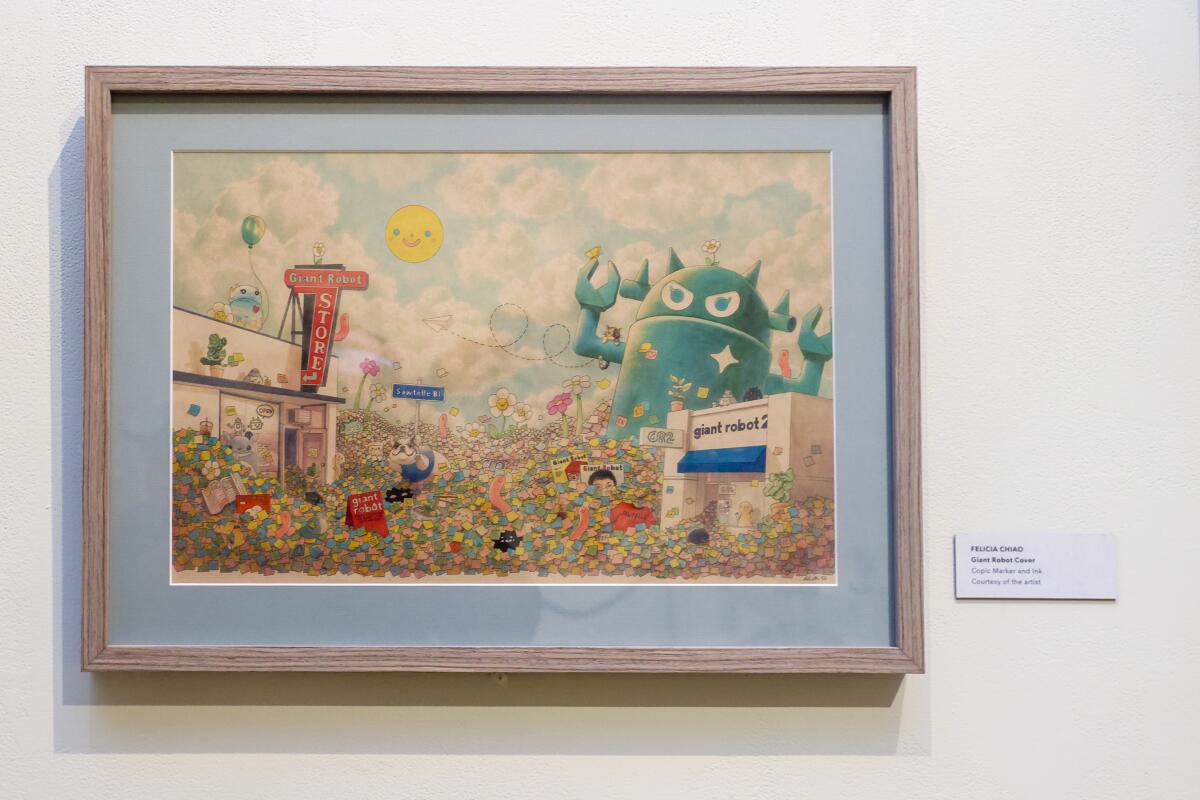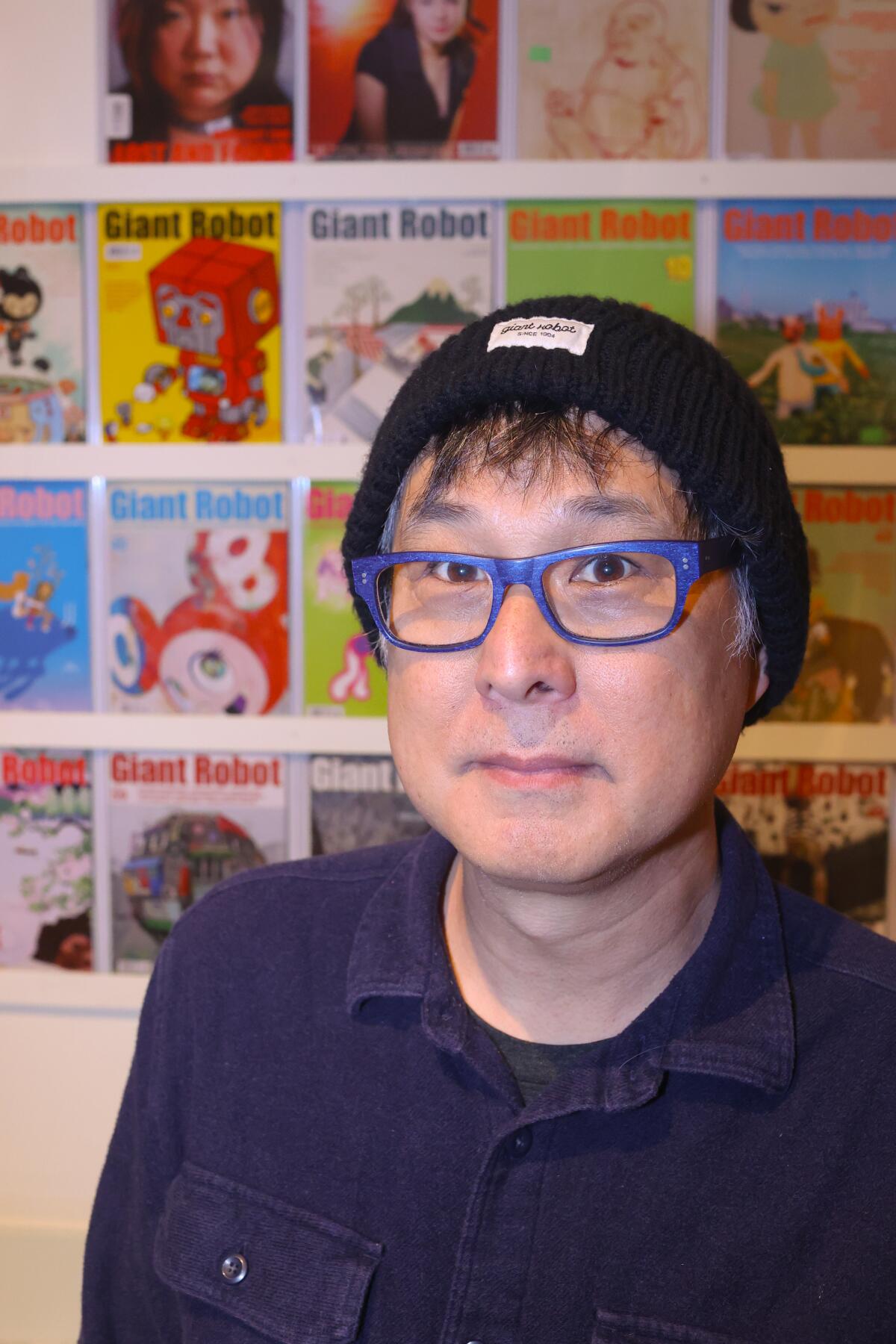
Eric Nakamura gives a tour while in front of a Sean Chao art piece entitled “Robot” at the Japanese American National Museum.
(Michael Blackshire / Los Angeles Times)
With “Giant Robot Biennale 5,” on view at the Japanese American National Museum through Sept. 1, the West L.A. native flashes back to his scrappy DIY days and showcases creatives who’ve been a part of his art ecosystem from the past to present day.
The group show features ceramicist Taylor Lee’s figures inspired by vintage Japanese sci-fi films, as well as Luke Chueh’s signature brooding bear paintings and a graffiti-inflected installation by Mike Shinoda of Linkin Park fame.
“I was like, ‘OK, the art has to echo this 30-year journey,’” Nakamura said of curating the exhibition, which ranges from multimedia works by longtime collaborator James Jean to small-yet-mighty watercolor pieces by emerging artist Rain Szeto.
“I used to hate looking back. I was always like, ‘What I’m doing now is most important.’ But for the first time, I went through all the archives, all the photos in tubs and tubs of one-hour photo envelopes, and started to organize. And I think that was just a good kick in the butt to understand: How did I start again, exactly? I took a deep dive into it by doing this exhibition.”
When the biennale opened March 1, more than 1,000 fans endured a labyrinthine line to glimpse the paper scraps, scissors and glue sticks used to make the very first zine. They scrutinized a collage of candid photos trying to ID the stars that orbited around Giant Robot in the late ’90s and early ’00s — from comedian Margaret Cho to rocker Karen O. And they posed for selfies in front of a wall covered with issues of Giant Robot magazine, the now-defunct full-color glossy that evolved from the zine and featured cover art by the likes of Takashi Murakami and Yoshitomo Nara. (The cult favorite bimonthly magazine, which Nakamura edited with friend and former colleague Martin Wong, folded in 2010 after 68 issues.)

Felicia Chiao’s “Giant Robert Cover,” framed and displayed at the Japanese American National Museum.
(Michael Blackshire / Los Angeles Times)
In the other gallery rooms, guests eagerly awaited their turn to interact with artists who started as Giant Robot fans and ultimately launched their careers by showing at Nakamura’s retail store and neighboring art gallery, GR2, on Japantown’s Sawtelle Boulevard.
Felicia Chiao, the San Francisco-based illustrator behind the biennale’s bubbly, fantastical promotional art, credits Giant Robot with being her entry into the art world: “In 2020, [Eric] gave me my first solo show ever. I wasn’t familiar with how galleries worked and I had no community at the time.”
One of her contributions to the show is a charmingly chaotic depiction of the busy block of Sawtelle. Nakamura used that same image as the cover art for his forthcoming book, “Giant Robot: Thirty Years of Defining Asian-American Pop Culture,” which drops in September.
“It’s super heartening to see AAPI [Asian American and Pacific Islander] artists thrive and succeed, and it shows others that it’s possible,” Chiao said. “No matter where my career goes, I think I can always come back for a sense of community and belonging.”
Biennale participants used the words “community” and “family” when discussing their working relationships with Giant Robot. In fact, Yoskay Yamamoto, whose serene papier-mâché and wood installation “Moonage Daydream” sits at the exhibition’s center, said he met his wife at GR2 in 2017, proposed to her at the gallery five years later and enlisted Nakamura to officiate at their wedding last year.
“In my mind, [GR2] is kind of like the Whisky a Go Go,” said painter Darren Inouye, who along with wife Trisha makes up the L.A. creative duo Giorgiko. “It’s a small location — if people didn’t know what to look for, they’d probably overlook it — but it has such a huge legacy. So many legendary artists have gone through their doors.”

An art piece by Giorgiko, titled “Broken Sakura,” is inspired by the internment camp experience of Darren Inouye’s grandmother.
(Michael Blackshire / Los Angeles Times)
Giorgiko’s contributions to the biennale reference the incarceration of Japanese Americans during World War II and include two pieces honoring Inouye’s grandmother, who was interned at the Santa Anita Assembly Center at age 14.
“I suppressed my Asian side very heavily growing up,” Inouye said. “I just wanted to be as ‘normal’ as possible. With Eric and Giant Robot, there was an element of a healthy amount of pride — not sweeping under the rug our ethnicity and history, but actually being able to highlight it.”

Eric Nakamura pauses for a portrait in front of Giant Robot magazine covers.
(Michael Blackshire / Los Angeles Times)
Back in the early ‘90s, that was Nakamura’s mission — to reach other young Asian American “underdogs” who shared his interests but didn’t see themselves represented anywhere in print.
“If you look at the very first [zine] issues, identity is a big deal,” Nakamura said. He added that though there were other Asian American students when he attended UCLA in the early ‘90s, “I still felt like an outcast there because I was into punk rock and had long hair … and maybe could have showered a little more.”
(Bringing things full circle, later this year, he’ll return to his alma mater to curate a multi-night film and television screening series celebrating Asian and Asian American artists at the Hammer Museum’s Billy Wilder Theater.)
“Creating a scene is really where it all comes from.”
